“My name is David, and I’m a caffeine addict.” Well, maybe…sure, we like that caffeine jolt in the morning, but if that was all it was about, we’d pop a No-Doz in our sleeping bag and let it do its thing before we tried to crawl out. No, unfortunately, it’s more complicated than that…the ritual, holding the hot, steaming mug of bitter wonderfulness and breathing the fumes is almost as important as the caffeine itself.
The coffee ritual may not quite be as old as time itself, but it certainly predates the Caucasian invasion of North America. For many, it goes beyond the drink itself; generations of adolescent males looked upon that first 4 a.m. cup at hunting camp as a rite of passage, their first acknowledgment of becoming a man among men.

However, the true awfulness of that camp cup is legendary in its own right. A couple of handfuls of grounds thrown into a pot of boiling water produces something that’ll curl your hair, even if you don’t have any. Methods to make it more drinkable are bandied about…add some salt, or an egg white, or even eggshells. None of ’em work.
Now, many hunting camps these days have electricity, and there are good solutions for car camping, too (including propane powered coffeemakers!). But for backpacking? Yup, that morning cup is about as close to rock bottom as it gets in this age of high technology.
Humans being what they are, though, solutions HAVE been created, with varying degrees of success. Hard-core AT thru-hikers who cut the handles off their toothbrushes have spent their “luxury” weight allowance on little enamel or aluminum espresso makers for years; yeah, they work, but they’re messy, difficult to use, and ridiculously inefficient. This is the 21st century, though, and if we can manage to create global warming, we ought to be able to come up with something better than that. In a spirit of true altruism, we decided to look around and see what we could find…and, in fact, it’s good! After a bunch of testing, we broke it all down into three categories; instant, drip, and french press. Read on for our favorites!
Backpacking Camp Coffee Options: Instant Products
No longer just “instant coffee” (which brings up soul-searing memories of Sanka), there are actually some mostly drinkable options in this class. First comes true instant coffee…granules or chunks in a jar, just waiting for some hot water to become liquid Ebola. Every once in a while, we get suckered into trying something new…I mean, “Medaglia D’Oro Instant Espresso” simply HAS to be better, doesn’t it? Ummm…no. It really isn’t.
The only thing we’ve found that actually is slightly better came from an oddball European import store, and goes under the label of “JFK Indian Instant Coffee”. The texture is a little finer (it’s spray dried, according to the can, and does have a very unusual, very fine crystal structure), the flavor a little less disgusting. It says right on the can, “Best Instant Coffee”, so of course it must be. Best use? Climbing Everest, where a few extra ounces might actually be a life-or-death choice. It IS, at least, cheap, at $1.79 for more than you’d ever want to drink.
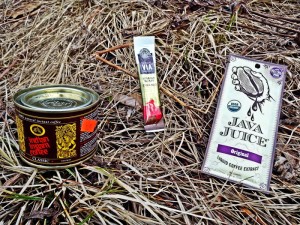
However, there ARE two instant options that are drinkable. The first is Starbucks’ “VIA”, a somewhat odd little packet with a mixture of instant coffee and microground coffee beans. The basic idea is that you’re sort of brewing itsy bitsy coffee beans that are so small you won’t notice when you drink the grounds, and will make you forget that there’s actual instant coffee in there too. And, it’s pretty close to the truth. The texture is ever-so-faintly gritty, but the flavor is MILES ahead of standard instant.
Oddly enough, though, it doesn’t have much, if any aroma, which was a big issue for some testers; as one put it “Coffee smells better than it tastes, so this is sort of the worst of both worlds.” Clearly, he hadn’t had enough caffeine yet that morning. Overall, though, people enjoyed it, particularly when they tasted it next to regular instant. Yes, it’s at a premium price over the other stuff (depending on where/how much you buy, it’ll run you a little under $1/cup), but worth it. In terms of quick, easy, light, and compact, this is pretty much the gold standard at this point.
The other option is coffee extract, The one we’ve tried extensively is sold under the name “Java Juice Espresso Concentrate
“. If you’ve ever gone on a cruise, you’ve likely had coffee made from extract (for them, finding space for everything they have to carry plus reducing weight is extremely important, so it’s extract over grounds). Java Juice definitely has some advantages over VIA, particularly in the texture; no grittiness. It has a relatively smooth, mellow flavor; it appears that the process of making the extract removes some of coffee’s “edge” and acidity. And, it doesn’t suffer from VIA’s lack of aroma; however, if you put it into near-boiling water, or put it into cold water and heat it, it “burns”, giving it an odd smell that one tester described as “hints of inner tube.” The best way to use it is to heat the water to a little hotter than you’d want to drink, then add it; that gives the best taste AND aroma (and, it reduces fuel use, as you don’t have to bring the water to a boil). If you’re going to use it when it’s cold out, take some hot water and pre-heat your cup before you put the water and extract in it for drinking, or you’ll have iced coffee shortly. If you like “burly” coffee, this is NOT for you…if you’re more a latte and cappuccino type, it’ll be right up your alley.
Downsides? It can be a little messy; once you open a packet, make sure that you put it somewhere safe OUTSIDE your tent if you don’t use it all in your first cup, or you’re pretty much guaranteed to have it all over everything you own (although Java Juice is now coming in little bottles; we’ll let you know how it works and tastes). And, finally, price; it’s a little more expensive than the VIA, generally a bit over $1, although it’ll make 10-12 ounces vs. VIA’s 8. Choose your weapon!
Backpacking Camp Coffee Options: Drip Products
Fair warning here…we tend to have a bias against drip coffee in camp. Why? It’s messy, fussy, and fraught with danger. Putting a big drip filter arrangement on top of a big container on a surface that’s not-quite-level and not-quite-stable is just looking for trouble, and Murphy tends to visit when you’re half awake; in other words, before you’ve had your coffee. If you want to see a grown man cry, watch him when he pours his hot water into a drip filter setup, just gets it to the top, and THEN it tips over.
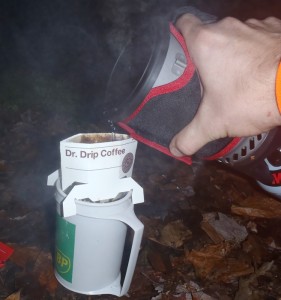
Beyond that issue is a pair of problems inherent to the drip process. The first is a time issue; drip requires pouring water into a filter…then more water…then more water…then…um, yeah. Boring at best, and really a pain on those mornings when you’re breaking camp and moving on. The second is that pouring HOT water into an open filter on a COLD morning leads to lukewarm coffee. Yuck. It’s often weak, too, as coffee gets its flavor from hot water going through the grounds. Three strikes, and drip is out.
Except…if you’re talking single cup. That’s much easier to deal with; shorter time to brew so less chance for it to get cold, smaller filter setup so less chance of tippage, and less damage to everything around if (when?) it DOES spill. There’s a host of options in this world, but most of them don’t excite us; they’re bulky, heavy, and just sit on top of the cup. Yeah, less likely to tip, but still pretty chancy in the morning fog (internal, not atmospheric). Still, there are a couple of options that actually make SOME sense.
The first is actually a disposable filter/coffee combination from Dr. Drip. We’ve tested it before, and found it good. It consists of a sealed packet with a cardboard filter pre-loaded with coffee grounds. Take it out, open it up, get it to sit on your cup, and pour water through. After you’re done, chuck the grounds and either burn the filter or tuck it back in the package and carry it out. It’s light, easy to use, surprisingly stable, and tastes VERY good. It’s the perfect option for the organizationally challenged; no possibility of getting out there, pulling out your filter, and finding you left your favorite grind at home. Weakness? Price; at $9 for 5 packets plus shipping, you’re talking coffee shop prices. But, at least the quality is closer to your favorite barista’s pull than the other prepackaged solutions we’ve tried.
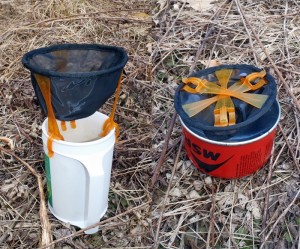
Now, if you can remember your coffee and want a more financially prudent solution, GSI Outdoors has a wonderful little gadget called the GSI Outdoors Ultralight Java Drip. Typical of GSI design, it’s made to fit inside the bottom of a fuel canister, taking up no useful space for the ultralighters. They aren’t kidding either; we were able to put it inside our GSI Outdoors MicroDualist Outdoor Cook Set, making one of the most extraordinary products we’ve tested even more amazing. And, at less than one-half ounce…well, that’s about the weight of the toothbrush handle they sawed off.
Slick little product, too, with legs on it that clip onto your cup. Stability is, for drip, excellent, as long as you’re awake enough to actually get the legs clipped on to your cup. Testers initially were disappointed, saying the coffee was “weak” and “thin.” Further testing found that the water moves through the filter so quickly that regular drip grind coffee doesn’t work; something more like an espresso grind is much better. And, even then, the most serious coffee afficionados felt that it took a very robust coffee to get a good flavor. Prepare your grounds appropriately, though, and you can get a very decent cup of coffee easily and pretty quickly.
Backpacking Camp Coffee Options: French Press
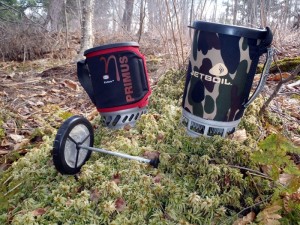
The exact opposite of drip for backpacking logistics, french press coffee is IDEAL for groups. Why? Because the water goes inside a carafe, which is then covered and put aside to brew. Chances of spillage, minor; loss of heat, much less. As with drip, there are a lot of options, including coffee cups which have their own little french press setup in them. We’re not big fans; those seem like too much weight, bulk, and mess. For solo drinking, we’ll probably stick with the drip.
But, we’ve got an old favorite and a new for multi-person joe. The old is JetBoil’s tried-and-true Jetboil Coffee Press. This is the hyperlight solution for any JetBoil user; at .8 ounce, it’s hard to make an excuse to not take it. And, at $14.95, it’s not exactly going to break the bank; coffee grounds are cheaper than VIA or Java Juice, so you’ll pay it off in no time. Weaknesses? Two. First, you have to be a Jetboil user (although the Primus EtaSolo has the same dimensions, so you can use the Coffee Press with that, as well). Second, French press coffee has always been famous for a certain amount of…well, mud in the bottom of the cup. And the nature of the JetBoil setup allows for more of it than your home press. It’s a tradeoff; it’s lighter, and muddier. We’ll forgive it its transgressions for the ease of getting that morning cup going. Sizing of the pot makes it ideal for two people, or possibly three; start getting up to 4, and you can’t get a decent cup for each person out of the first pot. Short someone on that initial cup, and you can pretty much assume there’s gonna be a fight, particularly when the coffee actually tastes good.

And now we come to the state-of-the-art in backcountry coffeemakers…the GSI Outdoors Java Press. Available in 50, 30, and 20 ounce versions, it’s simply the best coffeemaker we’ve ever taken backpacking, period. Why? Three reasons. First, it’s as unbreakable and undentable as anything we’ve seen. Second, it has an insulating sleeve around a plastic carafe with a double-walled insulating lid…it keeps coffee hotter than anything that could rationally be taken backpacking (GSI’s Glacier Stainless press might do better, but at twice the weight makes no sense at all. Plus, it costs more.) But third, and here’s the real kicker, it has an innovative silicone “wiper” around the plunger that virtually eliminates “mud,” without getting rid of the wonderful, creamy texture that french press is famous for. We compared it to our home press…it’s better.
People have used “oh, the coffee’s lousy” as an excuse to avoid going backpacking in the past; now, they have to avoid staying home! We’re fans of the 50 ounce press; it’s the most flexible in terms of the number of people that it can serve. At 14.6 ounces, it isn’t ultralight, but the 30 ounce press only saves 4.3 ounces, and we’ll carry the extra to only have to make a single pot most days. The 20 ounce version is sort of ridiculous; it weighs more than the 30, so it’s off our list. With a $37.95 retail, the 50 ounce Java Press a smoking hot bargain if you really care about your coffee.
Hundreds of jolts and buzzes later, we’re more convinced than ever that backcountry coffee doesn’t have to be your cross to bear anymore. With this many quality solutions, waking up in a tent just gets better and better. Pick your favorite, get out there, and enjoy a mountain sunrise with some good joe!


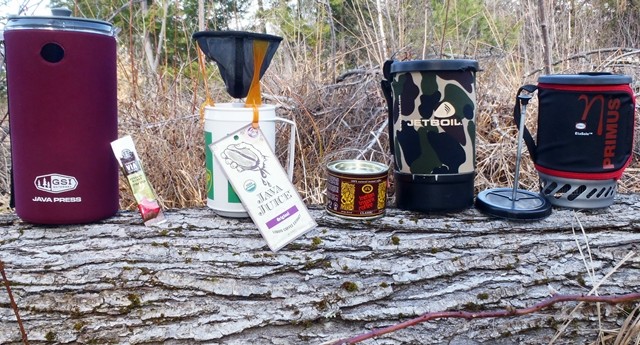
I agree that the GSI press in the 50oz model is the best coffee maker for backpacking you can have. I have used mine for a couple of years and have never regretted the purchase price. My old perk style pot takes 35 to 40 minutes of perking to get a 12 cup pot of drinkable coffee. The press will get you about the same amount of coffee after getting the water to boil and then waiting the 5 minute brew time. I have found that I like to use more coffee than is called for. I use the two tablespoon Chock Full of Nuts scoop and find that 5 scoops (10 Tablespoons) is good for a more robust coffee. It is way faster than perked.
If you’re into drip like me, you’ve gotta try one of these that I picked up on a fishing trip to Cape Town. Most compact coffee making contraption I’ve evr owned. Makes damn fine coffee too.
Jonas, we’d love to try it…but you didn’t tell us what it is!